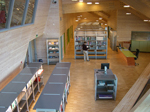
Featured PLC Member Library
The UNIS Library: A library in the far north

In Longyearbyen at 78° northern latitude you'll find an academic library – why?
In June 2006 Longyearbyen celebrated its centennial anniversary. Coal mining has been, and still is, the most important occupation; however, during the last decade, science and education have become increasingly important (see Svalbard statistics 2005).
UNIS (The University Centre in Svalbard) started in 1993 with only a few students and staff. Now, the institution is in its teens, and eager to grow larger and to play an even more important role in conducting research and education in the High Arctic.
Location means everything to us: The surrounding nature is an almost endless laboratory; there are glaciers nearby, sea ice most winters, dayside aurora and many high arctic species to study. Also, the infrastructure is very good – it only takes about one hour and thirty minutes between Longyearbyen and Tromsø in a commercial flight. In the peak seasons there are direct flights between Longyearbyen and Oslo that take only three hours. Since late January 2004 we've been connected to the mainland via a very fast fiber optic sub-sea cable, and this is vital to many activities in Longyearbyen. It truly was a revolution to the library's services as we could download full-text articles in no time and search databases without the previous time lag of the communication satellites.
The library covers biology, geology, geophysics and technology mostly related to the Arctic. Our patrons are faculty and students at UNIS, scientists from the Norwegian Polar Institute here in Longyearbyen, as well as scientists from a few other institutions that have an agreement with the library. Size and manpower are somewhat limited so the library isn't open to the general public.
Running a scientific library in this environment is challenging but also very rewarding. The library is continually growing – especially within full-text journals (at present there are more than 3500 full-text journals in subscription – mostly packages). Still, there are many information gaps to be filled and the library's handling of Inter-library Loan requests is crucial to our patrons.
by Berit Jakobsen, the UNIS library
